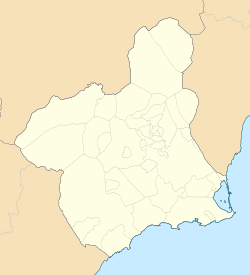Murcia
| Murcia | |||
|---|---|---|---|
| Municipality | |||
|
|||
| Location of Murcia within the Region of Murcia | |||
| Coordinates: 37°59′10″N 1°7′49″W / 37.98611°N 1.13028°WCoordinates: 37°59′10″N 1°7′49″W / 37.98611°N 1.13028°W | |||
| Country |
|
||
| Autonomous community |
|
||
| Province | Murcia | ||
| Comarca | Huerta de Murcia | ||
| Judicial district | Murcia | ||
| Founded | Between 825 and 831 | ||
| Government | |||
| • Alcalde | José Ballesta Germán (2015) (PP) | ||
| Area | |||
| • Municipality | 881.86 km2 (340.49 sq mi) | ||
| Elevation | 43 m (141 ft) | ||
| Population (2010) | |||
| • Municipality | 442,573 | ||
| • Density | 500/km2 (1,300/sq mi) | ||
| • Urban | 502,000 | ||
| Demonym(s) | Murciano/a | ||
| Time zone | CET (UTC+1) | ||
| • Summer (DST) | CEST (UTC+2) | ||
| Postal code | 30001 to 30012 | ||
| Dialing code | 968 / 868 | ||
| Website | Official website | ||
Murcia (/ˈmʊərsiə/ or /ˈmɜːrʃə/, Spanish: [ˈmuɾθja]) is a city in south-eastern Spain, the capital and most populous city of the Autonomous Community of the Region of Murcia, and the seventh largest city in the country, with a population of 442,573 inhabitants in 2009 (about one third of the total population of the Region). The population of the metropolitan area was 689,591 in 2010. It is located on the Segura River, in the Southeast of the Iberian Peninsula, noted by a climate with hot summers, mild winters, and relatively low precipitation.
Murcia was founded by the emir of Cordoba Abd ar-Rahman II in 825 with the name Mursiyah مرسية and nowadays is mainly a services city and a university town. Highlights for visitors include the Cathedral of Murcia and a number of baroque buildings, renowned local cuisine, Holy Week procession works of art by the famous Murcian sculptor Francisco Salzillo, and the Fiestas de Primavera (Spring Festival).
...
Wikipedia



